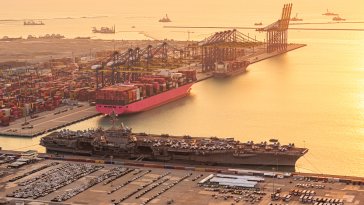
March Global Macro Monthly - Global reaction
- 26 March 2025 (7 min read)
KEY POINTS
Global Macro Monthly Summary March 2025
By David Page, Head of Macro Research
Equal and opposite reactions
Stock markets are not the best representation of a nation’s fortunes but changes can be instructive and unlike measures of GDP they are forward-looking. It is thus illustrative that over the last month, since the new US administration stepped up its tariff policies, the US S&P500 equity index fell by 10% (currently down 7.5%). Over that period other countries have responded to the new direction of US policy. Uppermost in our mind is the European reaction but China announced further domestic stimulus to address its own outlook. The Euro Stoxx and China’s CSI 300 index are down less than 1%.
Europe has so far seen the greatest reaction. While the European Union (EU) faces an uncertain future with further US tariffs expected in April, it has responded to the shifting geopolitical backdrop. Germany’s new Chancellor Friedrich Merz acted boldly to enact a change to the country’s debt brake even before its new Parliament sat. Germany will create a €500bn infrastructure fund for the coming decade and remove defence spending from its fiscal rules. This is an historic shift in German fiscal policy to manage the altered geopolitical realities of US security uncertainties. It has been matched by an EU-wide facility of €150bn of EU funds for defence, with a waiver to national governments for deficit constraints with regards defence.
It is unclear how much and how quickly governments will increase defence spending. It is likely to be a function of how quickly defence production capacity can increase within the EU (and those in EU defence pacts). But this looks set to be a material driver of growth over the medium term. Admittedly, the latest Summit highlighted problems for the EU in filling the US void. EU leaders were unable to progress €5bn worth of aid for ammunition to Ukraine and debated who would represent the EU at peace negotiations in which it is not yet a party. Another meeting is scheduled in Paris over the coming days. Democracies can take longer to affect change than autocracies, but they have other strengths.
The Eurozone’s economic outlook is mixed. Despite fiscal expansion, we see a minimal net impact on our growth outlook: we lowered our 2025 GDP outlook to 0.8% (from 0.9%) and leave 2026 unchanged at 1.2%. This reflects an expected greater impact of tariffs, the deferred fiscal boost and higher yields. But over the longer-term Eurozone growth could rise by around 0.5 percentage points (ppt).
China also responded to increased external pressure. Its latest National People’s Congress saw it set an ambitious growth target of “around 5%” for this year. To deliver this it announced a 2.1% of GDP increase in its total annual debt limit to provide a household and business sector boost. Overall, given the weak pace of consumption, we fear this will be insufficient to spur quick recovery and suggest actual growth will fall short of its target. However, the authorities appear to be embracing private sector enterprise, which should provide a bigger boost in business investment than previously hoped.
Canada has perhaps seen the biggest disruption from US policy to date. A recent business barometer collapsed to a record low, below readings recorded during the financial crisis and pandemic. The central bank is easing policy and looks set to continue careful stimulus, even as it keeps medium-term inflation expectations anchored. But Canada’s biggest shift may be political. Newly elected party leader Mark Carney became Prime Minister on 14 March and has called a General Election for 28 April.
Where his party stood over 20 points behind in the polls three months ago, they are now only 5 points behind. A win for Carney hangs in the balance and with it a potential pivot to Europe for trade and security alliances. On the other side of the US border, Mexico faces a perfect storm that sees the economy face the risk of recession, compounded by the threat of tariffs. However, Mexico has responded strongly to US demands – border security has been increased, collaboration surrounding drug cartels increased and Mexico has even proposed tariffs on China.
Country reactions are not limited to the above. Many are adjusting policy to reflect the short-term risks of US tariffs, the apparent shift in its security relationships and the broader geopolitical change. As we wrote before the election, these geopolitical shifts are highly unpredictable and may manifest in subtle ways on the macroeconomic landscape. One might argue that even Turkey’s latest foray into autocratic rule – President Erdoğan arrested Istanbul mayor and opposition leader Ekrem İmamoğlu – and its impact on the Turkish lira is a side effect of geopolitical developments that have seen Turkish regional importance grow. The EU has provided scant criticism of these developments so far.
Moreover, US developments are set to continue and likely get worse over the coming quarters. This will likely result in more direct headwinds to growth for many countries and a continued cost of uncertainty to all.
Related publications
Disclaimer
This website is published by AXA Investment Managers Australia Ltd (ABN 47 107 346 841 AFSL 273320) (“AXA IM Australia”) and is intended only for professional investors, sophisticated investors and wholesale clients as defined in the Corporations Act 2001 (Cth).
This publication is for informational purposes only and does not constitute investment research or financial analysis relating to transactions in financial instruments, nor does it constitute on the part of AXA Investment Managers or its affiliated companies an offer to buy or sell any investments, products or services, and should not be considered as solicitation or investment, legal or tax advice, a recommendation for an investment strategy or a personalized recommendation to buy or sell securities.
Market commentary on the website has been prepared for general informational purposes by the authors, who are part of AXA Investment Managers. This market commentary reflects the views of the authors, and statements in it may differ from the views of others in AXA Investment Managers.
Due to its simplification, this publication is partial and opinions, estimates and forecasts herein are subjective and subject to change without notice. There is no guarantee forecasts made will come to pass. Data, figures, declarations, analysis, predictions and other information in this publication is provided based on our state of knowledge at the time of creation of this publication. Whilst every care is taken, no representation or warranty (including liability towards third parties), express or implied, is made as to the accuracy, reliability or completeness of the information contained herein. Reliance upon information in this material is at the sole discretion of the recipient. This material does not contain sufficient information to support an investment decision.
All investment involves risk , including the loss of capital. The value of investments and the income from them can fluctuate and investors may not get back the amount originally invested.




